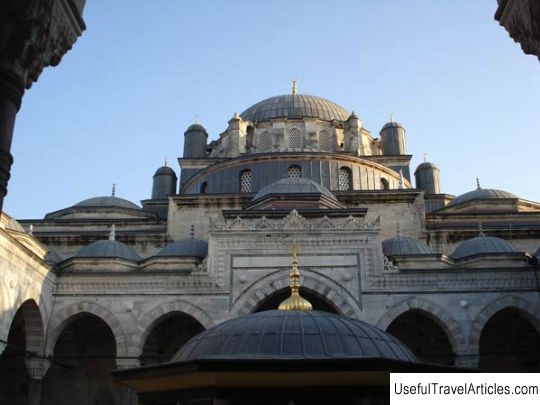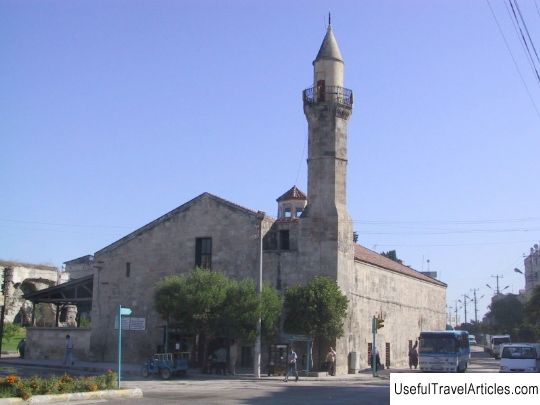Beyazit Camii Mosque description and photos - Turkey: Istanbul
Rating: 7,8/10 (303 votes) 
Beyazit Camii Mosque description and photos - Turkey: Istanbul. Detailed information about the attraction. Description, photographs and a map showing the nearest significant objects. The title in English is Beyazit Camii. Photo and descriptionThe Bayazid Mosque in Bursa, built by the architect Yakub Shah or Hayreddin Pasha in 1500-1506 by order of the son of Mehmed the Conqueror Sultan Bayezid II (reign: 1481-1512) - ancient, but at the same time, a striking and original, impressive building that gives an idea of the architectural style of the Ottomans of the Middle Ages, although not distinguished by the grace of the Green Mosque and not so lavishly decorated. This is the oldest surviving Sultan's mosque in the city, built in a transitional style from early Ottoman to classical, heavily influenced by the architecture of Hagia Sophia. It is one of the largest in Istanbul and has two minarets decorated with brick ornaments. It is located in the old part of Istanbul on Beyazit Square (the current name of the square is Freedom Square or Hurriyet Meidani). Not far from the mosque are the Beyazit Grand Bazaar Gate and the main gate of Istanbul University. The dome diameter is 17 meters. The minarets are decorated with brick ornaments. The mosque reflects the fashion for the construction of domed structures. Of particular interest is the rectangular front yard with arches. The entrance to the mosque is decorated with a gate decorated with rich and luxurious stalactite-like ornaments and inscriptions, which reflects the influence of the Seljuk in the architecture of the building. 25 domes rest on 20 antique columns made of red porphyry and pink granite. The dome diameter is 17 meters. The first interesting feature of the mosque is that the minarets are removed from each other a friend at a distance of about one hundred meters. The second feature is that this mosque, like most of the mosques built in the early Ottoman period, was originally created to accommodate merchants, pilgrims and wandering dervishes. In contrast to the mosques of the Seljuk epoch, the pool (or as the Turks call it - Shadrivan) is moved outside the premises into the courtyard. The color harmony of the arcade around the courtyard and the marble flooring are noteworthy. On both sides of the mosque there is a sherefe (a balcony on the minaret from which the muezzin calls to prayer), which is located at an altitude of 87 m. There are eight red stripes on the minarets, which give the mosque a special flavor. It should be noted that The trees from the construction sites were not removed by Turkish builders, so several cypress trees still grow in the courtyard of the Bayazid mosque, giving a very picturesque look to the entire ensemble. The plan of this building is very interesting. To the right and left of the entrance to the mosque, you can see 2 wings, which form a kind of porch with arcades with sharp arches. Standing at the extreme point of one of these porches, you can admire the grandiose spectacle, which is a long vaulted gallery in the form of a 25-domed portico and reminiscent of the monastery refectory of the Middle Ages. Ottoman architects covered the dome of the mosque with lead slabs, and a golden crescent was erected on the spire. Despite the fact that the mosque is one of the funeral ones, the tomb or “turbe” is located behind the mosque. Four small domes are located on each of the side naves, which were separated by columns. Around all the domes and half-domes, ornaments were depicted resembling patterns on fabrics, similar to the motifs of patterns applied to the tents of nomadic yuryuk, the ancestors of the Ottomans. Rise of Mahfil Hunkar, intended for the ruler-hyunkar was performed in a very elegant manner. In the mausoleum, which is an octagonal turba made of rough unhewn stone, behind the mosque, next to the tomb of Sultan Bayazid, Seljuk Khatun rests. A very famous person of the tanzimata period, the Great Reshid Pasha, was buried in the third turba in 1857. The complex, located on Bayazid Square to the west of Kapala Charshi, includes the Bayazid mosque itself, imaret (a dining room where servants ate , students, sick and indigent), hospital, school, madrasah, hamam (Turkish bath) and caravanserai. The caravanserai and imaret, considered a charitable institution in the Ottoman Empire, now belong to the city library, and the madrasah, which is located to the west of the mosque, now houses a museum of calligraphy. Among several mausoleums located on the south side of the mosque, there is the mausoleum of the founder of the mosque, Sultan Bayazid II. The Bayazid Mosque now houses the medical museum of the same name. To the north of the Bayazid Mosque is the complex of the old university, which became the first Turkish higher educational institution in the late 19th century.     We also recommend reading Assumption (Podolsk) Church description and photo - Ukraine: Zhytomyr Topic: Beyazit Camii Mosque description and photos - Turkey: Istanbul. |




